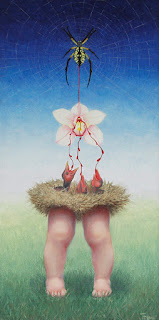a portrait of a "beatified" man holding an open pomegranate with bees buzzing around it.
The painting held my attention because as a former Catholic, the light around his head and face, his upward gaze and the use of color... the reds and oranges and yellows... and the use of light and dark, reminded me of Renaissance paintings of saints. This figure, "St. Ty" seemed to be in contemplation, which caused me to contemplate him... what was his story? What was he contemplating? He was wearing a red hoodie, set in modern times. Why was he being portrayed as a saint? And what was the significance of the pomegranate and the bees? What was the artist trying to say?
I stood in front of this painting for a long time, wrestling with what I didn't know and had no way to find out because there were NO ARTIST NOTES!!! (a pet peeve of mine) and in absolute frustration, I finally walked away. But I kept catching a glimpse of it out of the corner of my eye because I was drawn to the rich colors... I loved the use of light and shadow... so warm and inviting to me.
So as I'm turning away, trying to distract myself from this painting, a woman and her daughter walked up to me and started a conversation. It's Teresa Hill, the artist who created the painting that so drew and perplexed me. When I found out who she was, the first words out of my mouth were, "You're pomegranate guy! Ok, so what's the deal with pomegranate guy!"
As we talked, I found out that "St. Ty" is actually a portrait of her ex-husband, who used to be an animator for a well-known studio here in Los Angeles, and this is how she saw him... somewhat other-worldly, with a gift (the pomegranate). However, there was also the ideas of both pollination (life) and danger that surrounded him and his gift (his artistry) represented by the bees.
I found our conversation really enlightening and so enjoyable, not to mention the fact that it relieved my frustration over her painting, that I told her about Ikthos, and asked to do an interview with her and graciously she agreed.
On December 19th, one week before Christmas, Teresa and I met at Copa Vida, a coffee house in South Pasadena, California, to share coffee (for me, an elixir of life), conversation and thoughts on faith, her art and the meaning of life. The conversation that follows, most of which you will be able to hear below, was an hour and forty-three minutes long, which I've condensed to an hour and twenty-three minutes (sorry that was the best I could do. There's a lot of good stuff).
 |
| "The Whistling" |
 |
| The Hatchling" |
To my more traditional believers out there, I would ask that you listen to our conversation without judgment. Teresa has gone beyond most of our comfort zones, but the echoes of what we were taught are still there. I have to admit that I don't agree with all that she believes in, and that's perfectly ok. We respect each other enough to listen to each other, which I believe is much needed in the body of Christ today and I know I grew from our conversation, as I believe she did as well. We plan on speaking again.
I believe this is all a part of the journey Christ intended us to have as we each "run our own race". She is running her race and I am running mine and maybe by sharing our stories of lessons learned, we can assist one another. The body of Christ, "joint supplying joint."


